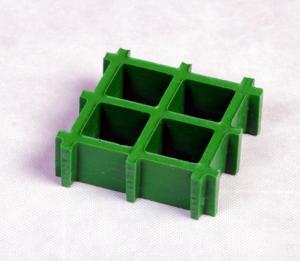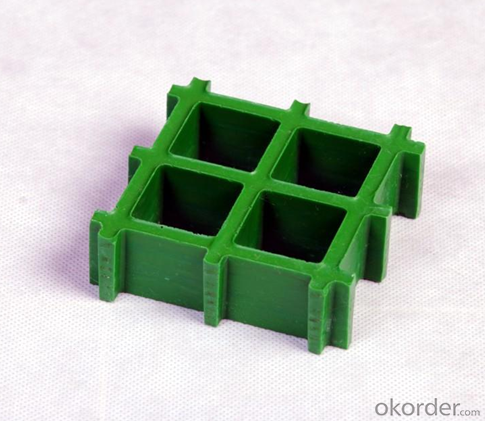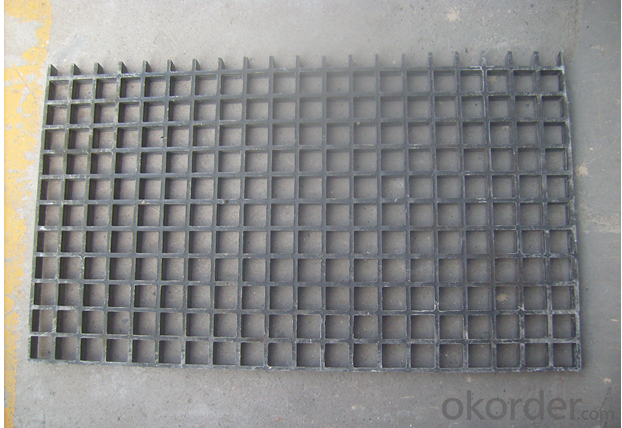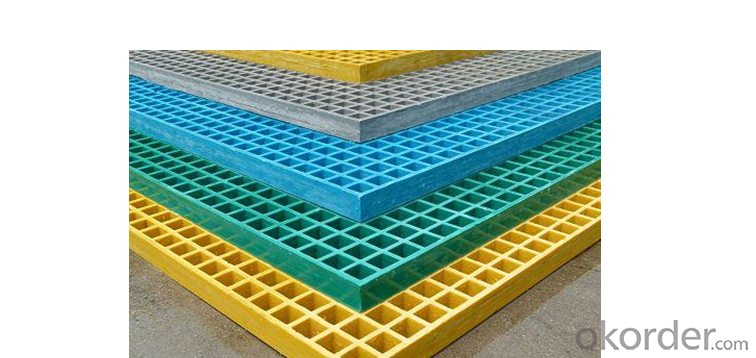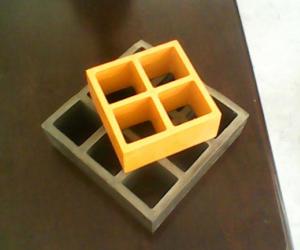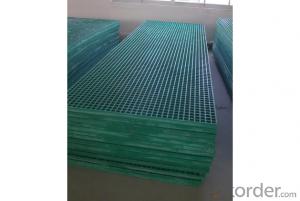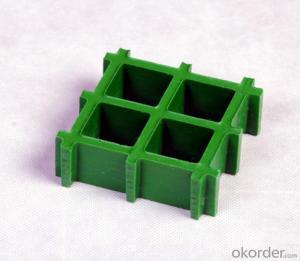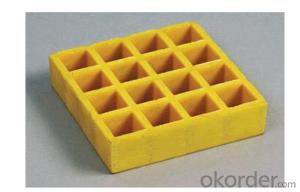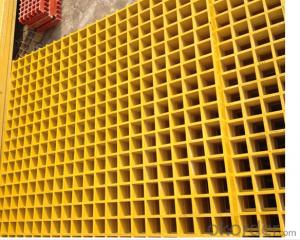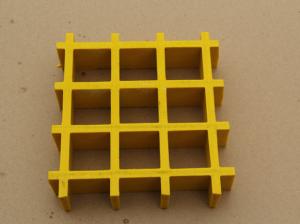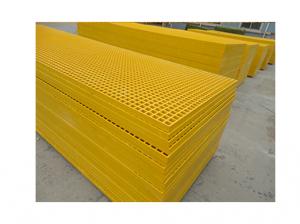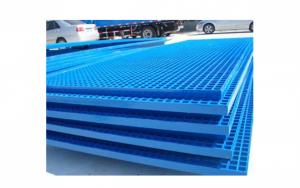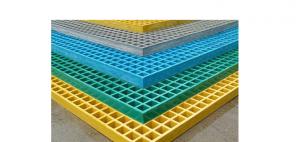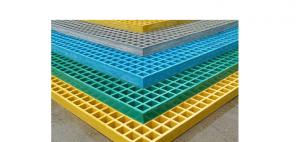FRP Pultrusion Profiles Molded Gratings - Fiberglass & Plastic Grating Floors in Various Colors with Best Quality
- Loading Port:
- China main port
- Payment Terms:
- TT or LC
- Min Order Qty:
- 100 m²
- Supply Capability:
- 5000000 m²/month
OKorder Service Pledge
OKorder Financial Service
You Might Also Like
Introduction
FRP Molded Grating is a structural panel which uses high-strength E-Glass roving as reinforcing material, thermosetting resin as matrix and then casted and formed in a special metal mold. It provides properties of light weight, high strength, corrosion resistance, fire resistance and anti-skid. FRP Molded Grating is widely used in oil industry, power engineering, water & waste water treatment, ocean survey as working floor, stair tread, trench cover, etc. and is an ideal loading frame for corrosion circumstances.
Feature
Corrosion Resistance
- Safety & Anti-slip
Electrical Insulating
Aging Resistance
Specification
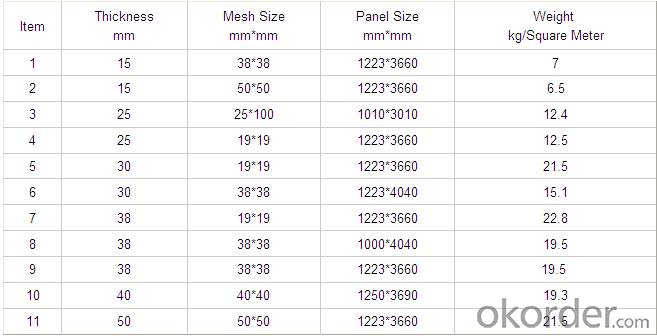
Advantage
coated with prevent aging layer
excellent insulating performance
no maintenance
- easy installation
Application
Pool railings in sewage treatment industry
Corrosive chemical industry equipment around the fence
All kinds of building maintenance section
FAQ
1. How about the documents after shipment?
After shipment, we ll send all original documents to you by DHL, including Packing List.Commercial Invoice, B/L, and other certificates as required by clients.
2. Do You Arrange Shipment?
Yes, dear esteemed customers, for FOB or CIF price, we will arrange shipment for you. For EXW price, clients need to arrange shipment by themselves or their agents.
3. How is the package?
Usually, we arrange the standard out-package for exporting.
PROCESS
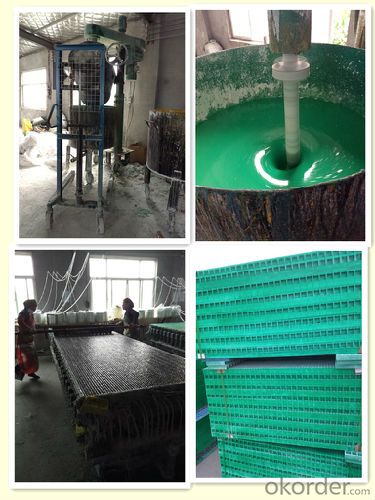
FACTORY
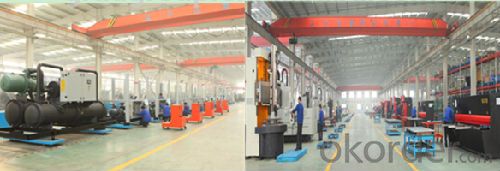

- Q: How are FRP pultrusion profiles manufactured?
- FRP pultrusion profiles undergo a highly controlled and precise manufacturing process. The process consists of several steps. To begin with, the raw materials are carefully chosen. These materials typically include reinforcing fibers like fiberglass, carbon fiber, or aramid, as well as a thermosetting resin matrix. The selection is based on the desired mechanical properties of the final product. Following that, the resin matrix thoroughly saturates and coats the reinforcing fibers. This can be achieved by immersing the fibers in a resin bath or using a resin injection system. Once the fibers are fully impregnated, they are pulled through a heated steel die. The die not only shapes the pultrusion profile but also activates the resin's curing process. This allows the resin to harden and bond the fibers together. While passing through the die, the fibers are continuously pulled by a set of rollers or a gripper system. This pulling force ensures that the profile maintains its shape and dimensions, resulting in a consistent and uniform product. After leaving the die, the profile enters a cooling zone where it is rapidly cooled using air or water. This rapid cooling helps solidify the resin and stabilize the profile's shape. Finally, the cured and cooled profile is cut to the desired length, often using automated cutting systems. Additional finishing processes, such as surface treatment, sanding, or painting, may be implemented to meet specific requirements or enhance the profile's aesthetics. In conclusion, the manufacturing process for FRP pultrusion profiles combines the impregnation of reinforcing fibers with resin, the shaping of the profile through a heated die, and the curing and cooling steps. This process enables the production of lightweight, corrosion-resistant profiles with high strength. These profiles find applications in various industries, including construction, aerospace, automotive, and electrical.
- Q: How do FRP pultrusion profiles perform in heavy-load applications?
- FRP (Fiber Reinforced Polymer) pultrusion profiles are known for their exceptional performance in heavy-load applications. Due to their high strength-to-weight ratio, these profiles can withstand substantial loads without compromising structural integrity. The pultrusion process ensures that the fibers are uniformly distributed and aligned along the length of the profile, resulting in superior strength and stiffness. In heavy-load applications, FRP pultrusion profiles exhibit excellent load-bearing capabilities. They have a high modulus of elasticity, meaning they can resist deformation under heavy loads, ensuring long-term durability. These profiles also have a high ultimate tensile strength, allowing them to withstand extreme forces without breaking or deforming. Furthermore, FRP pultrusion profiles are corrosion-resistant, making them ideal for heavy-load applications in harsh environments. Unlike traditional materials like steel, FRP does not rust or corrode, ensuring a longer lifespan and reduced maintenance costs. Another advantage of FRP pultrusion profiles in heavy-load applications is their electrical insulation properties. They do not conduct electricity, making them suitable for environments where electrical conductivity is a concern. Additionally, FRP pultrusion profiles are lightweight compared to traditional materials like steel or concrete. This characteristic not only simplifies transportation and installation but also reduces overall project costs. In summary, FRP pultrusion profiles perform exceptionally well in heavy-load applications. Their high strength-to-weight ratio, excellent load-bearing capabilities, corrosion resistance, electrical insulation properties, and lightweight nature make them a preferred choice for various industries, including construction, infrastructure, marine, and transportation.
- Q: Can FRP pultrusion profiles be used in electrical or telecommunications applications?
- Yes, FRP pultrusion profiles can be used in electrical or telecommunications applications. FRP (Fiber Reinforced Polymer) pultrusion profiles have excellent electrical insulation properties and are resistant to corrosion, making them suitable for use in electrical and telecommunications infrastructure. Additionally, their light weight, high strength, and design flexibility make them a desirable choice for applications such as cable trays, support structures, and enclosures in these industries.
- Q: What is the impact resistance of FRP pultrusion profiles?
- FRP pultrusion profiles exhibit a remarkably high level of impact resistance. These profiles are produced by pulling reinforcing fibers, such as fiberglass, through a resin bath and then into a heated die, where the resin solidifies and cures. This manufacturing technique generates a durable and robust composite material with exceptional mechanical properties, including impact resistance. The impact resistance of FRP pultrusion profiles may differ depending on the specific formulation, design, and orientation of the reinforcing fibers employed. Nevertheless, in general, FRP pultrusion profiles have been proven to possess superior impact resistance when compared to traditional materials like steel or aluminum. The combination of reinforcing fibers and the resin matrix in FRP pultrusion profiles provides enhanced strength and toughness, enabling the profiles to withstand substantial impact loads without cracking, breaking, or deforming. Consequently, these profiles are highly suitable for a diverse range of applications where impact resistance is of utmost importance, such as in construction, transportation, and sporting goods. Furthermore, the impact resistance of FRP pultrusion profiles can be customized by adjusting factors such as fiber content, fiber orientation, and resin type during the manufacturing process. This allows for tailored profiles that meet specific application requirements. In summary, FRP pultrusion profiles deliver outstanding impact resistance due to the integration of reinforcing fibers and resin matrix. Their exceptional strength, toughness, and ability to endure impact loads make them a dependable choice across various industries and applications.
- Q: Can FRP pultrusion profiles be used in infrastructure projects?
- Yes, FRP (Fiber Reinforced Polymer) pultrusion profiles can be used in infrastructure projects. FRP pultrusion profiles offer several advantages over traditional materials such as steel and concrete. Firstly, FRP profiles are lightweight, yet still possess high strength-to-weight ratios. This makes them easier to transport and install, reducing construction time and costs. Additionally, their lightweight nature ensures they do not exert excessive loads on the supporting structures. Secondly, FRP profiles are corrosion-resistant. Unlike steel, FRP does not rust or corrode when exposed to harsh environmental conditions, making them ideal for infrastructure projects located in coastal areas or regions with high humidity. This corrosion resistance extends the service life of the structures and reduces maintenance requirements, resulting in long-term cost savings. Thirdly, FRP pultrusion profiles offer excellent durability and dimensional stability. They are highly resistant to fatigue, creep, and environmental degradation, ensuring the longevity and structural integrity of the infrastructure. Their dimensional stability also means that they maintain their shape and structural properties over time, reducing the risk of deformation or failure. Furthermore, FRP profiles can be customized to meet specific project requirements. They can be manufactured in various shapes, sizes, and strengths, allowing for versatile applications in infrastructure projects such as bridges, walkways, railings, support structures, and utility poles. Overall, the use of FRP pultrusion profiles in infrastructure projects offers numerous advantages, including lightweight construction, corrosion resistance, durability, and customization options. These benefits make FRP profiles a viable and cost-effective alternative to traditional materials for various infrastructure applications.
- Q: Are FRP pultrusion profiles resistant to chemicals used in food packaging?
- Yes, FRP pultrusion profiles are generally resistant to the chemicals commonly used in food packaging. The combination of fiberglass reinforcement and resin matrix used in FRP profiles provides excellent chemical resistance, making them a suitable choice for applications involving contact with food packaging chemicals. However, it is always recommended to consult with the manufacturer or supplier to ensure specific compatibility with the chemicals involved.
- Q: Can FRP pultrusion profiles be used in chemical processing plants?
- FRP pultrusion profiles are indeed applicable for use in chemical processing plants. These profiles possess exceptional resistance to corrosion, rendering them suitable for chemical settings that frequently involve exposure to diverse chemicals, acids, and bases. Moreover, FRP pultrusion profiles exhibit a combination of lightness and strength, allowing for customization to satisfy specific design prerequisites, thereby enabling their adaptability for various applications within a chemical processing plant. Additionally, they possess non-conductive electrical properties, proving advantageous in environments necessitating electrical insulation. On the whole, FRP pultrusion profiles present a durable and cost-efficient resolution for chemical processing plants, as they deliver long-term performance and reduce maintenance expenses.
- Q: Can FRP pultrusion profiles be used in electrical insulation applications?
- Yes, FRP pultrusion profiles can be used in electrical insulation applications. FRP (Fiber Reinforced Polymer) materials have excellent electrical insulation properties, making them suitable for a wide range of electrical applications. The pultrusion process ensures that the profiles have uniform insulation properties and high strength, making them ideal for use in electrical insulation applications.
- Q: Can FRP pultrusion profiles be used in the renewable energy and solar power industry?
- Yes, FRP (Fiber Reinforced Polymer) pultrusion profiles can be effectively used in the renewable energy and solar power industry. FRP pultrusion profiles possess several key characteristics that make them ideal for such applications. Firstly, FRP pultrusion profiles have high strength-to-weight ratio, meaning they are lightweight yet strong, which is crucial in the renewable energy sector where materials need to withstand various environmental conditions while being cost-effective. Secondly, FRP pultrusion profiles offer excellent corrosion resistance, ensuring durability and longevity in outdoor and potentially corrosive environments, such as solar power plants or wind farms. Additionally, these profiles have excellent electrical insulation properties, making them suitable for electrical applications commonly found in the renewable energy industry. Moreover, FRP pultrusion profiles can be easily customized into various shapes and sizes, enabling the design and engineering of complex structures required for solar power installations or wind turbine blades. Furthermore, FRP materials are non-conductive and non-magnetic, making them safe for use in electrical and magnetic fields associated with renewable energy systems. Overall, FRP pultrusion profiles offer a combination of strength, durability, lightweight, corrosion resistance, and electrical insulation properties that make them highly suitable for use in the renewable energy and solar power industry.
- Q: Are FRP pultrusion profiles resistant to chemicals used in food processing?
- Yes, FRP pultrusion profiles are generally resistant to chemicals used in food processing. Fiberglass reinforced plastic (FRP) is known for its excellent chemical resistance, making it suitable for various industrial applications, including the food processing industry. FRP pultrusion profiles are composed of a combination of resins and fiberglass reinforcements, which provide them with inherent resistance to a wide range of chemicals. FRP pultrusion profiles are typically resistant to acids, alkalis, solvents, and many other chemicals commonly found in food processing environments. This resistance ensures that the profiles will not corrode, degrade, or react with the chemicals, preserving their structural integrity over time. This makes FRP pultrusion profiles a reliable choice for equipment, structures, and components used in food processing facilities. However, it is important to note that the specific chemical resistance of FRP pultrusion profiles can vary depending on the resin system used in their manufacturing. Different resins offer different levels of resistance to specific chemicals. Therefore, it is crucial to select the appropriate resin formulation that matches the specific chemical environment in the food processing industry. To ensure the compatibility of FRP pultrusion profiles with the chemicals used in food processing, it is advisable to consult with the manufacturer or supplier. They can provide detailed information on the chemical resistance properties of their FRP profiles and assist in selecting the most suitable materials for the specific application. Additionally, proper maintenance and regular cleaning practices should be implemented to ensure the longevity and continued chemical resistance of FRP pultrusion profiles in food processing environments.
Send your message to us
FRP Pultrusion Profiles Molded Gratings - Fiberglass & Plastic Grating Floors in Various Colors with Best Quality
- Loading Port:
- China main port
- Payment Terms:
- TT or LC
- Min Order Qty:
- 100 m²
- Supply Capability:
- 5000000 m²/month
OKorder Service Pledge
OKorder Financial Service
Similar products
Hot products
Hot Searches
Related keywords
